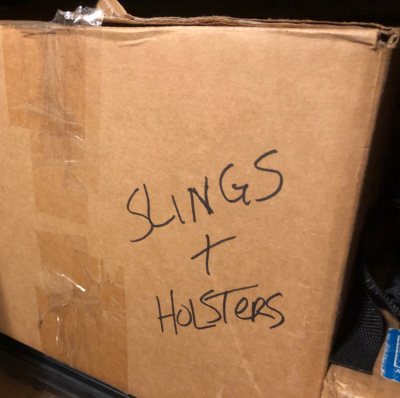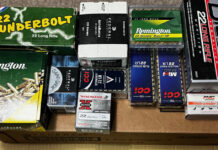Over the years, I have had ammunition stored in cardboard sleeves corrode, #10 cans rust, elastic in stored clothing lose its stretchiness, batteries leak corrosion, pasta poke through vacuum-sealed bags, mice eat stored food, and plastic handles on buckets fail. The sad truth is that you cannot store something away and expect it to be perfect five or ten years down the road. You need to check on it occasionally to preserve your investment. This will allow you to prevent an infestation before it gets too bad, repackage something before its current container fails, or replace it if you cannot salvage it. No one wants to grab their bugout bag and have the strap break due to rot or find out that the action on their rifle is frozen just when they need it most.
If you have equipment you plan to depend on in adverse conditions, test it out at least one a year. Can you still pump up your Coleman stove or does it leak? And how long do those lantern wicks last, anyhow? Will your generator start when you need it to? Will your hand-crank grain mill still turns or do you need to buy some food-grade grease? Does your red dot still light up or are the batteries dead? Is it OK that some white granular stuff is leaking out of the crimp on your shotgun shells and the brass is tarnished? Will your seeds still germinate? When did chain sharpening files get rusty, and will they still work in that condition? How long ago did your antibiotics expire? Who used up the last of the yeast and didn’t replace it?
Rotate Stored Fuel
Prior to Hurricane Ida coming through, I poured the contents of my oldest Jerry can of gasoline into my truck and took the empty can down to the station and filled it up with ethanol-free gasoline. Then I topped my truck off with the same stuff. Once I got back home, I added some PRI-G fuel stabilizer and used a Sharpie to write “August 2021–No Ethanol” on the can. I then moved all the other cans forward a step and placed this can in the back of the line. This helps ensure I use the oldest gasoline first. Using 100 percent gasoline is better for small engines in generators and chain saws than using gasoline with ethanol, so that is what I try to keep on hand. It will still work fine in your vehicle and costs a bit more than standard unleaded.
If you store gasoline or diesel, use a fuel stabilizer designed for your fuel. Even when treated, you should rotate it. I find the easiest way to rotate it is to pour it in your car. When you spill it down the side of the car and onto your shoes, that will teach you to get a good funnel, a lesson that is better to learn now than when it is too late.
This should go without saying, but you don’t need to rotate propane. That stuff is good forever if the canister doesn’t leak.
Speaking of gasoline, when you put away any devices with a small engine, if you will not use it in the next 30 days, make sure you empty the gas tank and drain any fuel from the system. Then try to start the device to make sure it burns up any residual gas.
Recharge Batteries
Two days before Ida came ashore, I started charging batteries and devices. I have the two double-bay and one quadruple-bay chargers, giving me the capacity to charge eight 18650 lithium batteries at once. I also have flashlights and headlamps that will accept a USB cord and charge the batteries inside, but I prefer to use my high-end LiitoKala Lii-500 intelligent charger with LCD display because it tells me how run down the batteries were, has better diagnostics and provides finer control over how the battery charges. This helps be identify what brand of batteries hold their charge best and which ones suck. I like to make sure I have the good batteries in all my safety and survival equipment.
I also charged my AA and AAA Ni-MH cells and topped off the Ryobi 18-volt batteries in the workshop. Recharging everything was complicated by having to dig batteries out of my car survival kit, my bugout bag, my EDC bag, and two storage locations.
Check Your Water Filter
Here’s the bad news about water filters: If you use them, they need to be cleaned before you store them away. So if you took your water filter on a camping or backpacking trip, or if you used it in an emergency, make sure you clean it out and dry the components, especially the filter, before storing it away when you no longer need it.
If you use a filter with ceramic elements, inspect the elements to ensure they are not broken. Sometimes these critical elements can shatter during or rough handling. Inspect your filter at least annually to ensure it is in tip-top shape and has no build up of mold, algae or dirt that could affect its performance. Check the manufacturer’s user guide or website for information on how best to maintain your water filter.
Check Expiration Dates
Around here, we take most expiration dates with a grain of salt. We take them more seriously for prescription medications and anything stored in the refrigerator (like salad dressing). For canned goods, dry food, and dehydrated or freeze-dried foods, we play it more loosely. However, if we find a can of grocery-store food that is more than two years beyond its best buy date, we try to eat it fairly soon and replace it with something new.
There are a few exceptions for canned food. For example, we try to use anything from the tomato family within the expiration date. Canned tomato products, like diced tomatoes and tomato paste, are acidic and can eat away at the can, causing it to fail. While this was more common in the past, before cans had a polymer liner, it can still happen. (Ask me how we know.) For canned items that contain liquid, I recommend turning the can over a couple times a year. This keeps any food that floated to the top from drying out and prevents the surface from growing a skim. We do this for things like soup, stew and canned vegetables.
Keep Your Gear Ready for Use

The other day when I went target shooting, I realized that a few long guns in my safe don’t have slings, so I set about to fix that. Luckily, I had this big cardboard box in my labeled “Slings & Holsters.” Inside, I found seven slings, two of which were brand new and still in their original packaging. In fact, the leather 1907 sling may be the best of the bunch, but I don’t consider it suitable for every gun.
One sling was an early M16-style cotton sling made of webbing. Another was an older surplus sling. I don’t recall what gun it was made for, but I previously used it on a Ruger 10/22 when I took my kids to the Appleseed course. A few of the slings ended up in the box because they were not well designed or were outdated. For example, these slings pre-dated the quick release (QR) sling mounts. On my guns that had slings, I use Magpul or similar slings that convert from single point to two-position.
Still, a surplus, cheap, or outdated sling is better than no sling. Just as I outfitted all my ARs with back-up iron sights last year, I added slings to my guns, even the ones that will spend most of their life in the safe.
I hope I never have to rely on that old A2 with a carry handle I bought in the 1990s to save my life, but if I have to, it will have an original sling on it. At the very least, I’ll be able to carry it over my shoulder.








